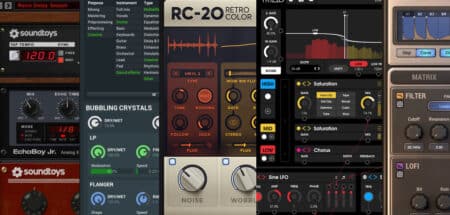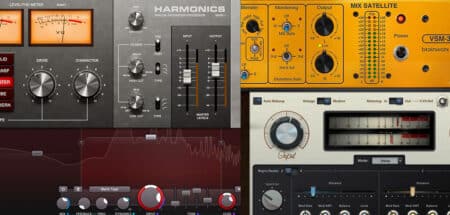[the_ad_placement id=”top-content-300×250″] Arturia’s polychrome synth Pigments brings together a huge amount of the considerable synth knowledge that the French company has spent the last 20 years collecting and refining while building the instruments that make up their much-loved V Collection and classic effects collections.
But Pigments goes further than being simply an amalgamation of Arturia’s greatest hits: it features several different synthesis and sampling types, it’s own novel modulation system and powerful sequencing possibilities, and it attempts to house all this power and complexity in a sleek and intuitive interface that is fast and easy to use.
With Pigments now up to version 3, I thought it was the perfect time to take a look at what has been added in this latest version and how Pigments as a concept is maturing. I also wondered how it stacks up against the competition vying for your attention and allegiance in the fierce arena of modern soft synths. Does Pigments 3 do enough to stand out?
Let’s mix some colours…
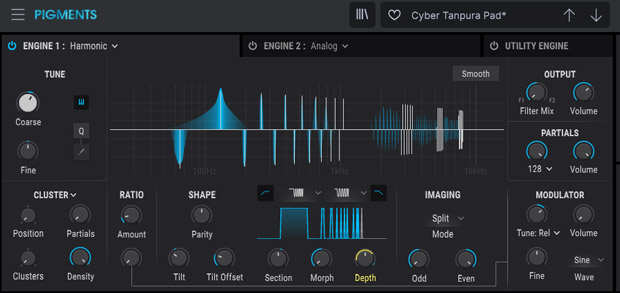
What’s New in Pigments 3?
Harmonic Engine: joining the existing Analog, Wavetable (which includes some simple FM and phase distortion functionality) and Sample (with additional granular processing!) Engines, Pigments now has Additive synthesis capabilities courtesy of the Harmonic Engine. Unlike the subtractive nature of the Analog engine, additive works by adding harmonics or partials to a fundamental tone, for glassy-to-buzzy futuristic sounds not too dissimilar to classic FM. The Additive engine in Pigments offers control and modulation of up to 512 partials, as well as morphing and dual formant filters.
Utility Engine: Also supplementing Engines 1 and 2, you now have an all-new third, the Utility Engine. This one provides two noise sample layers and an extra oscillator layer. A great way to add some subtle sampled atmospheric grit, and/or a beefy lower-octave sub oscillator to your sounds, respectively.
Wavetables: The original set of 100 have been added to with 64 new ones. By my reckoning, that’s 164 total! You can also create and import your own wavetables and samples, offering near-infinite options for experimentation and customisability of your base sounds.
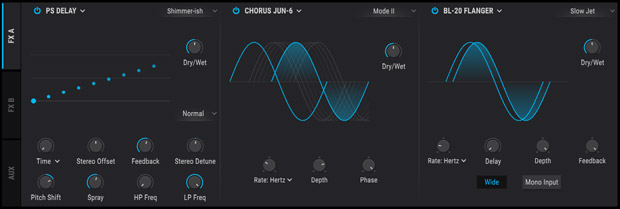
New Filter and Effects Options: Pigments has featured some cherry-picked filters and effects lifted directly from some of the V Collections most celebrated emulations since the last version, and these are now accompanied by the Jup-8 low-pass filter, and the JUN-6 Chorus for a touch of Roland magic. There’s also the vintage-emulating BL-20 Flanger, and by contrast, the decidedly non-vintage and excitingly modern-digital Pitch Delay.
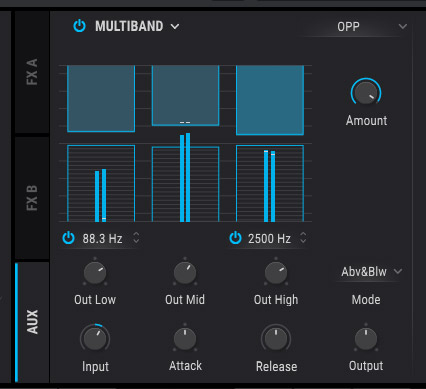 Enhanced Filter Routing: You can now route each of the filters to either of the effects buses, providing quite a lot more sound design flexibility and nuance.
Enhanced Filter Routing: You can now route each of the filters to either of the effects buses, providing quite a lot more sound design flexibility and nuance.
Multi-band compressor: A useful addition for making your patches sound very much mix-ready without necessarily needing further plugin processing, the multi-band comp goes along with the “self-contained, thoroughly modern sound design one-stop shop” ethos of Pigments.
New Presets: 300 fresh presets from a large team of experienced pro sound designers, bringing the factory library up to 700+ presets. The optional extra Spectrum Sound Pack also adds another 500 presets in 5 banks of 100, providing an extra-vast canvas of inspiration and guidance for developing your own sound design skills, or an excellent pool of ready-to-go sounds for those who want quick access to quality patches without having to get their hands too dirty under the hood. The presets are nicely laid out using Arturia’s excellent and filterable preset library format, that will of course be already familiar to users of the V Collection instruments.
Built-in Tutorials: Pigments will be a fantastic instrument for relative newcomers to synthesis, since it couples its myriad synthesis types with a bank of excellent and clear tutorials built right into the plugin.
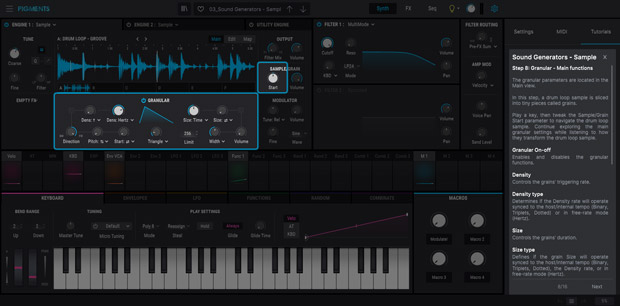
Beyond the overview technical specifications though, the things about Pigments 3 that really stand out to me are the overall sonic quality and character, the modulation system, the sequencer, and finally, the value for money.
The Sound
Pigments 3 sounds great, quite “modern” in contrast to some of the most “vintage” emulations in the V Collection, while still remaining rich and characterful by contemporary synth plugin standards, and clearly connected to the lineage of the classic machines through some of the borrowed filters and effects. So you can make Pigments sound more or less vintage (which is itself a very modern feature, I suppose). I had a lot of fun producing varying degrees of cool 90s synth flavours in particular, and many of the presets are geared towards the trend for that eras sonic aesthetics — although of course, it’s certainly not limited to recreating any one decades sounds.
The new additive synthesis Harmonic Engine further enhances Pigments ability to provide real cutting edge, warping and twisting sounds that have a cool FM-like sheen but with extra futuristic bite. 
Meanwhile, it can seem that you can’t mention “wavetable” without invoking the, “But how does it stack up against Serum?” question. Happily, with such a massively versatile tool as Pigments, these kinds of questions are actually largely moot and sidestepped by the fact that this synth is so much more flexible and multi-faceted than most of what might be thought of as “competitors” (in fact they each have their strengths, of course). In terms of wavetable functionality, Pigments lets you further mangle your wavesets with simple frequency and phase modulation, phase distortion and wavefolding. You can import samples to create your own custom wavetables, and of course most significantly, you can combine a Wavetable Engine with an Analog oscillator, a Sample (granulated or not), an Additive noise or another wavetable!
All of this while, in use, seeming not very complicated at all, very intuitive and with a general aesthetic feeling of “openness” about the synth, which I think is partly down to the clean, non-skeuomorphic design, and partly down to the “let’s see how many cool, “dream synth” features we can bolt together while keeping things fundamentally simple” attitude that seems to underpin the whole enterprise.
Modulation System
One of Pigments most immediately eye catching (and as it turns out on closer inspection, one of the most powerful) aspects is the modulation system. The Modulation Overview strip across the middle of the interface gives you an immediate summary of what is happening, and you can very quickly click through to any source for more info or to assign additional routings.

It’s very visual, which on very first impression I found a bit distracting, but skip ahead 20 minutes to having made a few custom patches later, and I had very happily clicked with the amount of information being presented, noticing how the colour-coded mod sources provide a quick-glance overview of which animated wiggling line is actually doing what (more on that below). I wish I had had these kind of visual indicators of what my envelopes and LFOs were actually doing when first learning synthesis and sound design, so I can only say that for less experienced users this will be a godsend and massively enhance your rate of progress in understanding and effectively implementing the core principles and tools of synthesis. And if you already have some experience, the Pigments mod system, coupled with the broad synthesis type options, will encourage even deeper, more complex and more nuanced modulation routings than you might have been tempted to try and wrangle with before.
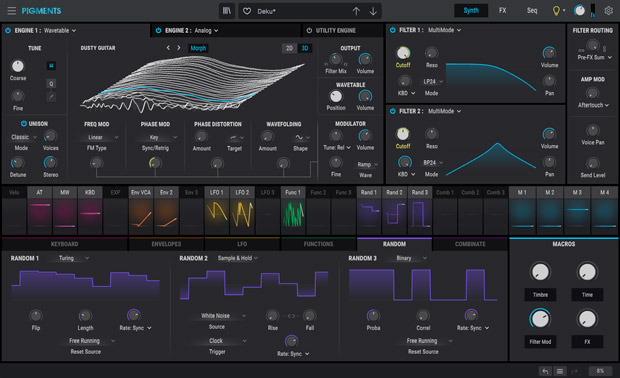
You’ll be aided in programming these advanced modulations by the series of modulation source options: alongside the expected ADSR envelopes and LFOs, you also have three other modulator types: Functions, Random and Combinate. The three available Functions are essentially multi-stage envelope generators (MSEGs) which you can shape and curve to your liking, adding up to 64 breakpoints, and set to cycle like LFOs or trigger once like a regular envelope. Under the Random tab, you have three random signal generators that can each be set to Turing, Binary or the classic Sample & Hold randomised patterns — ideal for injecting various shades of organic randomness into your patches in exactly the ways and amounts you would like. Finally, the three Combinate functions each generate modulation signals based on the interactions of one or two other modulation sources. While other synths and plugins might make this kind of feature into a tedious mathematical exercise, Pigments, in typical fashion, makes it easy and fun (via its simple dropdown Type, Source and Mod selectors) to produce radically complex mod sources that you can use to inject extreme levels of nuance and liveliness into your programmed sounds.
The Sequencer
I ended up spending an inordinate amount of my time preparing this article playing with Pigments sequencer, and it’s turned out to be possibly my favourite aspect of the plugin. It’s very full-featured for a sequencer built into a synth, featuring many of the “deep cut” controls and parameters that you would usually hope to find only in a dedicated sequencer plugin: polyrhythmic, individually adjustable lane lengths, randomisation options for virtually every parameter (pitch, trig probability, gate length etc.) for breathing life and completely programmable amounts of spontaneous variety into your sequences and rhythms; also the per-step parameter locks enable you to just go crazy experimenting with randomising everything and then gradually honing your sequenced steps into melodies and phrases that you wouldn’t otherwise generate manually.
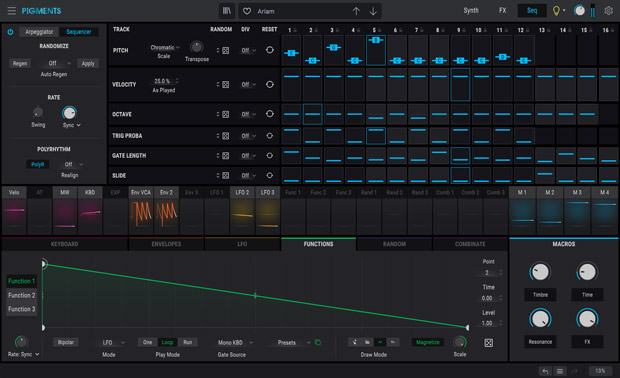
And in fact, Pigments can output MIDI generated by its sequencer, so you can then send it to any other VSTi in your collection — this is not a typically enabled in most soft synths, but with Pigments, you not only get a cool sequencer for driving Pigments own sound engines, but you can use it to explore and reinvigorate the rest of your synth collection as well! It’s another way that Arturia have found to make Pigments stand out in a crowded field: kudos to them for that.
Incredible Value
Considering how many synthesis and sound design options Pigments 3 packs in, it represents pretty exceptional value. At its regular price of $199, it offers a huge amount; if it were the only synth in your collection, you could easily make vast numbers of different-sounding tracks in any number of styles by exploring everything Pigments has to offer. In the meantime, you would also be getting a pretty thorough grounding in every important aspect of modern synthesis, making it a fantastic “desert island” synth for learners and experienced users alike. The sound quality is pristine and never feels remotely compromised: this is a professional-grade instrument for serious production.
Conclusion
In terms of style and where it fits relative to the competition, Pigments 3 seems designed to sit somewhere between the immediacy of the Serums and Sylenth1s on the one hand, and the relatively open-ended “everything and the kitchen sink” sonic playgrounds of UVI Falcon, Zebra2 or the many analog-modular-inspired software instruments on the other. But really, that might be overthinking it, because I feel now that Pigments 3 kind of sits in a category of its own.
There’s a cool sense that Pigments’ developers and designers are rapidly exploring and discovering just what Pigments itself is, and what it could be. There’s an exciting air of breaking new ground in the way so many facets of synthesis and sound design are brought so neatly together, adding new features and watching this thing grow as an instrument in multiple different directions at once. It’ll be fascinating to watch where Arturia might take Pigments next, but for now, I’m going to put such questions to one side, roll up my sound-making sleeves and continue exploring the considerable fruits of their experiments so far.
Available for: Mac, PC | VST, AU, AAX
Find out more at Arturia.
[button link=”https://www.pluginboutique.com/product/1-Instruments/4-Synth/5018-Pigments?a_aid=500567b977a31″ target=”_blank” preset=”blue” text_color=”#ffffff” color=”#238bcd”]BUY NOW[/button] via Plugin Boutique.






